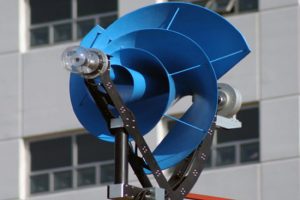
Dear EarthTalk: Given all the advances in residential household efficiency, can you paint a picture of what the home of the future will look like?
—Jennifer C., Valmeyer, IL
No doubt, homes in the future, whether single family dwellings or apartments in larger buildings, will be much greener than what we are all living in these days. For starters, the use of sustainable, locally sourced (and ideally recycled) materials will be the norm, not the exception, so as to avoid the unnecessary emissions and resource consumption required to make new stuff and ship it around the world.

Homes of the future will be energy efficient. Part of this efficiency will come from better insulation, doors and windows to keep the heat/cold inside where you want it. The other part will come in the form of using renewable energy generated on-site, whether from rooftop photovoltaic solar panels, thin-film window treatments, solar shingles, micro wind turbines, kinetic energy harvesters, or other newfangled technologies. And all this self-sustaining energy will be stored in your own high-capacity batteries probably not so different from Tesla’s Powerwall array.
Homes of the future will also be smart. Your appliances, A/C, lighting, home security, motorized blinds, garage door openers and other systems will be connected to your network with controls available through apps over the Internet. And chances are, your future home will be smaller. The “tiny house” movement highlights how much homeowners can save on utility bills when space is limited. Efficiency can also be about use of space as much as about use of energy. While we won’t all live in tiny homes, downsizing will definitely continue to be “in.”
And what about outside your home? Don’t be surprised if your perfect lawn has been replaced by native plants attuned to the surrounding ecosystem. These hardy local plants won’t need chemical fertilizers, herbicides or pesticides to thrive. Rainwater from your roof will be collected in cisterns, with the resulting “graywater” used to irrigate your landscaping. A green roof or vertical garden could top it all off.
While the picture painted above may seem far-fetched, it’s really not, given that you could build a home that met all of the above criteria today for not much more than a conventional home. That said, it might be greener still to retrofit your existing old-school home with eco-friendly upgrades than to tear it down and build a new one, given the emissions associated with manufacturing, materials transport and assembly on a new structure. While the new home will be more efficient, it could take decades to “pay back” the “carbon debt” accrued by building from scratch.
Of course, all buildings run their course eventually, so when it is time to tear-down, it’s good to know there are plenty of green options out there to replace the old homestead. And with California adopting new building codes that go into effect in 2020 calling on all new construction of single-family homes and low-rise apartments to meet zero net energy standards (whereby they generate as much power from on-site renewables as they consume from the grid), the future may be here sooner than we imagined.
CONTACTS: Tesla Powerwall, tesla.com/powerwall; “Tiny Homes Are Big On Energy Efficiency,” ase.org/blog/tiny-homes-are-big-energy-efficiency; “CA Building Code Takes Big Step Toward Net-Zero Energy,” nrdc.org/experts/pierre-delforge/ca-building-code-takes-big-step-toward-net-zero-energy.
EarthTalk® is produced by Roddy Scheer & Doug Moss and is a registered trademark of the nonprofit Earth Action Network. To donate, visit www.earthtalk.org. We’d love to get your question answered right here on AmericaJR! Send questions to: question@earthtalk.org.
EarthTalk® is produced by Roddy Scheer & Doug Moss for the 501(c)3 nonprofit EarthTalk. To donate, visit www.earthtalk.org. Send questions to: question@earthtalk.org.
